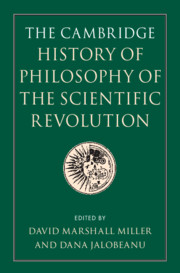Book contents
- The Cambridge History of Philosophy of the Scientific Revolution
- The Cambridge History of Philosophy of the Scientific Revolution
- Copyright page
- Contents
- Tables and Figures
- Contributors
- Preface
- Introduction The Disciplinary Revolutions of Early Modern Philosophy and Science
- Part I The Disciplines
- Part II Disciplinary Activities
- Part III Problems and Controversies
- 17 Galileo’s Sidereus Nuncius and Its Reception
- 18 Instruments and the Senses
- 19 Science of Mind
- 20 Circulation and the New Physiology
- 21 From Metaphysical Principles to Dynamical Laws
- 22 The Debate About Body and Extension
- 23 Space and Its Relationship to God
- 24 The Vis Viva Controversy
- Bibliography
- Index
20 - Circulation and the New Physiology
from Part III - Problems and Controversies
Published online by Cambridge University Press: 14 January 2022
- The Cambridge History of Philosophy of the Scientific Revolution
- The Cambridge History of Philosophy of the Scientific Revolution
- Copyright page
- Contents
- Tables and Figures
- Contributors
- Preface
- Introduction The Disciplinary Revolutions of Early Modern Philosophy and Science
- Part I The Disciplines
- Part II Disciplinary Activities
- Part III Problems and Controversies
- 17 Galileo’s Sidereus Nuncius and Its Reception
- 18 Instruments and the Senses
- 19 Science of Mind
- 20 Circulation and the New Physiology
- 21 From Metaphysical Principles to Dynamical Laws
- 22 The Debate About Body and Extension
- 23 Space and Its Relationship to God
- 24 The Vis Viva Controversy
- Bibliography
- Index
Summary
William Harvey’s demonstration of the circulation of the blood is one of the Scientific Revolution’s most influential and lasting achievements. But in spite of Harvey’s innovation, and paradoxically given the extent to which he came to be represented as a founder of modern science, he tied himself to ancient authorities and sought to insulate natural philosophy and the art of medicine from the new mechanical-corpuscular and chemical philosophies of the period. The reception of Harvey’s work, both in physiology and later in embryology, shows that Harvey’s research program won numerous early converts, who used his program for their own ends, including support for the new philosophies, in the cases of René Descartes and Robert Boyle. Untethered from his preferred Scholastic framework, Harvey’s conceptual foundations, techniques, and conclusions led to new discoveries, and unresolved questions in Harvey’s account about the movement of the heart, nature of the blood, and respiration would motivate intense inquiry. The circulation of the blood and later physiology therefore provide an essential perspective for the examination of early modern disputes about experimentation and its limits, the rhetoric of novelty, the unity of nature, and the very notion of life.
Keywords
- Type
- Chapter
- Information
- The Cambridge History of Philosophy of the Scientific Revolution , pp. 369 - 386Publisher: Cambridge University PressPrint publication year: 2022

